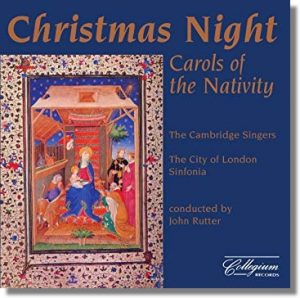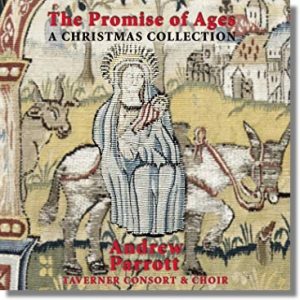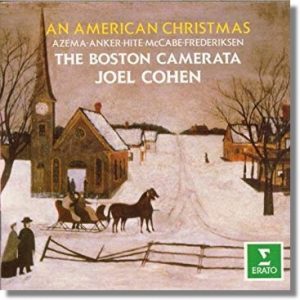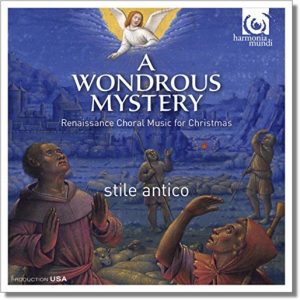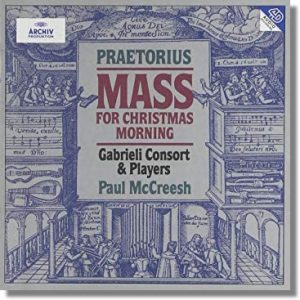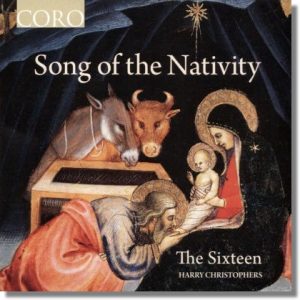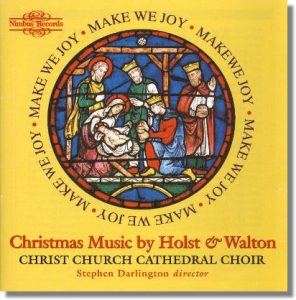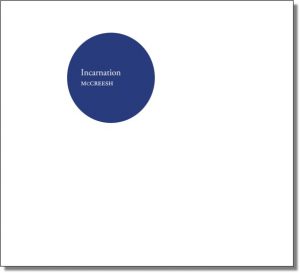In 2018, I spent the 12 Days of Christmas compiling a short list of some of my favorite recordings of Christmas music. If I were to do the same thing this year (or any year) the list would probably be different, as I discover new albums or revisit some that I had long forgotten. The 2018 list also evidences my interest in commending a range of different styles and eras, not just polyphony from the Renaissance (which forms a large portion of my listening).
Below are links to the 12 posts that introduce the albums I surveyed in 2018. Most of the posts include embedded performance tracks that provide a taste of the entire album. Some of these are more readily available in various formats than others (although none are or have ever been solely obtainable on vinyl). And all of them are on my iPhone, so if you have questions, see me after the service on Christmas day or anytime thereafter, and don’t be shy.
Happy listening!
Christmas Night: Carols of the Nativity
The Cambridge Singers, conducted by John Rutter
“ . . . This album includes twenty-two pieces, and the CD booklet helpfully informs us that all but three of them are arrangements taken from books of carols published by Oxford University Press (and, not incidentally, co-edited by John Rutter; the man’s a commercial genius!). Our parish choir has sung four of these works in Christmases past. These include a setting of the Christina Rossetti poem which we sing every year as a hymn, In the bleak mid-winter. Our hymn version is by Gustav Holst (of The Planets fame); the version for choir and soloist is by Harold Darke (1888-1976). . . .”
The Promise of Ages: A Christmas Collection
Taverner Consort & Choir, conducted by Andrew Parrott
“ . . . The Promise of Ages: A Christmas Collection actually features only the women who sing in Parrott’s ensemble, joined by female members of the New London Chamber Choir and the Henrietta Barnett School Choir. This feminine presence reflects not that this music is just about Mary, but that it is about Mary and the amazing things she experienced. It encourages us to view the Nativity from her point of view, not just from our own vantage point, let alone from some detached and distant ‘wide shot.’ . . .”
While Shepherds Watched: Christmas Music from English Parish Churches and Chapels, 1740-1830
Psalmody and The Parley of Instruments, Peter Holman, director
“ . . . The album’s subtitle indicates that the selection of music here includes music from chapels as well as parish churches, so some of the selections are from the hymnals of nonconformists. But all of the music is performed in the style known as ‘west gallery music’ or ‘Georgian psalmody.’ The latter term is a reference to the era of the four Georges who ruled from 1714 to the 1830s. The reference to west galleries is an architectural designation. Many church buildings in this time included balconies at the west end of the nave, altars being situated at the east end. As many of these churches had no organs to accompany singing, choirs and instrumentalists would sit or stand in these galleries during a service, out of sight but certainly not out of mind as they plied their robust (and often primitive) music-making. . . .”
Noëls Celtiques — Celtic Christmas Music from Brittany
Ensemble Choral du Bout du Monde, Christian Desbordes, director
“ . . .A few songs on this album have known Welsh or Cornish ancestry, some are identified simply as ‘traditional,’ and a few are more recent compositions. All of them are sung in Breton by the L’Ensemble Choral du Bout du Monde (the ‘World’s End Choir’). Formed in 1977 and directed by Christian Desbordes, the choir unites singers from across North Finistère for the purpose of promoting the Breton language and culture. Accompanied by flutes, accordions, bagpipes, guitar, and organ, the soundscape is unlike any other recording in my collection. This disc has become a bit like a holiday desert in our home every Christmas. . . .”
An American Christmas: Carols, Hymns and Spirituals, 1770-1870
The Boston Camerata, Joel Cohen, conductor
“ . . . While many of the works in this collection are from anonymous sources, some are the work of recognized poets and composers, the most famous being William Billings (1746–1800). Most of Billings’s music is known by the tune title, not by the texts (many of which he wrote himself), so one might for forgiven for not realizing that a work entitled ‘Boston’ is the story of the angels appearing to shepherds to announce the Nativity. . . .”
A wondrous mystery: Renaissance Choral Music for Christmas
Stile Antico
“ . . . One of the most intriguing pieces here is Mirabile mysterium by Jacob Handl (1550–1591). The text to this motet is an antiphon sung at Lauds on the Feast of Circumcision: ‘A wondrous mystery is declared today, an innovation is made upon nature; God is made man; that which he was, he remains, and that which he was not, he takes on, suffering neither commixture nor division’ Handl uses a series of unpredictable harmonic progressions to capture the sense that something disorienting — or, better, re-orienting — is happening in the Incarnation, and thus, in the world. (In the notes that accompany this recording, the adjectives “astonishing” and startling” are used descriptively.) At the end of the work, the Latin phrase ‘non commixtionem passus’ (‘suffering no commixture’) is repeated over and over, underscoring this important fact about Christ’s two natures. A wondrous mystery indeed. . . .”
Praetorius Mass for Christmas Morning
Gabrieli Consort and Players, conducted by Paul McCreesh
“ . . . Michael Praetorius (1571-1621) played a profound role in shaping the Lutheran musical tradition as it developed from the late Renaissance into the early Baroque. The son of a devout pastor who had studied with Martin Luther, Praetorius has often been called the ‘conservator of the chorale,’ the Lutheran chorale being the fundamental building block of music in this rich tradition — a musical ecosystem that produced J. S. Bach. In addition to his work as an organist and prolific composer, Praetorius was also a significant music theorist. . . .”
Song of the Nativity
The Sixteen, Harry Christophers, conductor
“ . . . Listening to this recent collection, I was reminded of how new aesthetic expressions are richly intelligible only in relation to a tradition. What gives the splendid newer works on this recording their power (e.g., Morton Lauridsen’s O magnum mysterium, James MacMillan’s O radiant dawn, and other less celebrated pieces) is their relationship with a history of composition and singing, a matrix of meaning that includes the events celebrated (the Nativity, the shepherds, etc.), the collection of artifacts that memorialize those events (texts, tunes, and arrangements), and the communal practices in and over time that connect us with the transcendent realities embedded in those events, artifacts, and experiences. . . .”
Make We Joy: Christmas Music by Holst and Walton
Christ Church Cathedral Choir, Stephen Darlington, director
“ . . . As David Trendell notes, ‘Both composers were attracted to the long tradition of the English Carol, and in keeping with contemporary ideas, such as the rediscovery of folk-song, medieval texts and the idea of an English musical renaissance, they moved away from the sentimental Victorian conception of the carol to a purer form.’ . . . To hear what that commitment sounds like, consider Walton’s setting of the fifteenth-century carol, Make we joy, composed on commission by a Manchester newspaper, which first published it in 1931 (my, how journalism has changed). . . .”
Christmas with the Tallis Scholars
The Tallis Scholars, Peter Philips, conductor
“ . . . This album explores a wide range of Medieval and Renaissance Christmas music, including carols, motets, and masses. There are composers from England, Spain, Germany, France, and the Low Countries. There are familiar pieces (e.g. Es ist ein Ros’ entsprungen by Michael Praetorius [1571–1621], the same harmonization we sing as “I know a rose-tree springing,” #17 in our Hymnal) and some remarkable and rarely heard gems (e.g., the seven-part motet Beata es Virgo Maria by Philippe Verdelot [1480?–1532?]). . . .”
Cristóbal de Morales: O Magnum Mysterium — Christmas Motets
Weser-Renaissance, conducted by Manfred Cordes
“ . . . O magnum mysterium is the first motet in this album of Christmas-themed music sung by the Weser-Renaissance ensemble, conducted by Manfred Cordes. I say ‘Christmas-themed,’ since there are pieces here associated more precisely with Advent (Veni Domine, et noli tardare, ‘Come, Lord, and do not delay”), with the Annunciation (Ave Maria), and with the Virgin Mary more generally (Salve regina, “Hail, Queen”). But the miracle of the Incarnation celebrated during Christmas isn’t exclusively or primarily about the Nativity, so such a broad definition of ‘Christmas motets’ can be defended. . . .”
Incarnation
Gabrieli Consort, conducted by Paul McCreesh
“ . . . This album alternates between Christmas music from the twentieth and twenty-first centuries and music from the medieval period. The musical styles of those two eras have an affinity but they also have very different qualities, which McCreesh wanted to juxtapose. . . . The richness of 20th and 21st century English choral music, with its beautifully written polyphony and often richly astringent harmony, sometimes needs a ‘palette cleanser.’ I’m not for a moment suggesting that the medieval music here — beautiful and worthwhile in its own right — only serves that function, but it does provide necessary relief before the next onslaught of glorious lush harmony. . . .”
